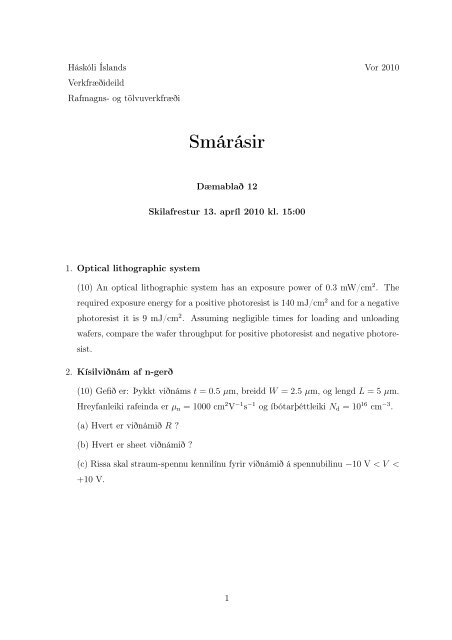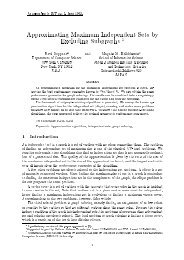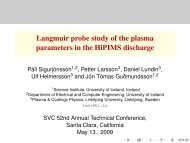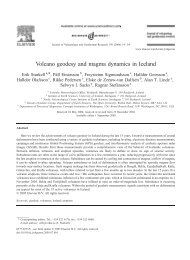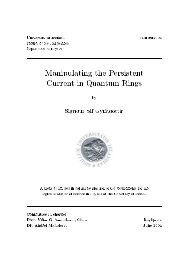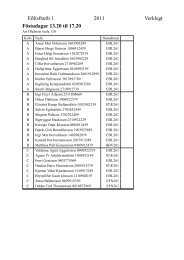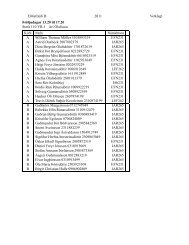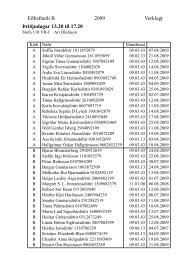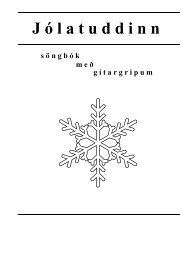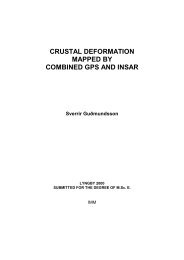Dæmablað 12 - Háskóli Ãslands
Dæmablað 12 - Háskóli Ãslands
Dæmablað 12 - Háskóli Ãslands
- No tags were found...
Create successful ePaper yourself
Turn your PDF publications into a flip-book with our unique Google optimized e-Paper software.
Háskóli Íslands Vor 2010VerkfræðideildRafmagns- og tölvuverkfræðiSmárásirDæmablað <strong>12</strong>Skilafrestur 13. apríl 2010 kl. 15:001. Optical lithographic system(10) An optical lithographic system has an exposure power of 0.3 mW/cm 2 . Therequired exposure energy for a positive photoresist is 140 mJ/cm 2 and for a negativephotoresist it is 9 mJ/cm 2 . Assuming negligible times for loading and unloadingwafers, compare the wafer throughput for positive photoresist and negative photoresist.2. Kísilviðnám af n-gerð(10) Gefið er: Þykkt viðnáms t = 0.5 µm, breidd W = 2.5 µm, og lengd L = 5 µm.Hreyfanleiki rafeinda er µ n = 1000 cm 2 V −1 s −1 og íbótarþéttleiki N d = 10 16 cm −3 .(a) Hvert er viðnámið R ?(b) Hvert er sheet viðnámið ?(c) Rissa skal straum-spennu kennilínu fyrir viðnámið á spennubilinu −10 V < V
3. Val á skrefara(10) Tiltekið lithography kerfi sem notar G-línu sem ljós (λ = 436 nm) getur gefiðminnstu prentanlega stærð sem 0.5 µm með dept of focus (DOF) sem 1 µm. Nýframleiðsla þarf að hafa minnstu prentanlegu stærð sem 0.2 µm með dept of focus0.15 µm. Þrír skrefarar standa til boðaλNASkrefari A 365 nm (I- lína) 0.7Skrefari B 248 nm (excimer leysir) 0.85Skrefari C 193 nm (ArF) 0.85Gera skal ráð fyrir að stuðullinn k 1 sé fastur og að k 2 = 0.5. Hvaða skrefari uppfyllirbæði kröfur um minnstu stærð og depth of focus ? Sýna skal útreikninga semrökstyðja niðurstöðuna.(Próf maí 2004)4. Advanced lithographic system(10) Advanced lithographic equipment tends toward low wavelength exposure throughhigh numerical aperture (NA) lenses. Modern systems have λ = 193 nm and NA ∼0.9. Let us assume that k 1 = 0.3 and k 2 = 0.75.(a) Find the depth of focus (DOF) and the minimum half pitch (HP) achievable inthis system.(b) Find DOF and HP if NA = 1. Is this even physically possible? Why or whynot?(c) 193 nm lithography can be pushed very far using methods like immersion lithography(next question below), photoresist trimming, and double patterning. 193 nmimmersion was done specifically to avoid the jump to 157 nm lithography, for whichthe cost was too high for such a marginal gain in minimum HP. What is the nextstep in optical lithography after 193 nm ? Does it use refractive optics ? If not,then what kind of optics does it use, and how is it achieved ? Cite a reference (2maximum) to support your answer.2


